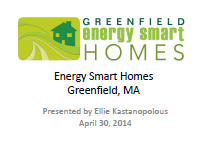Energy Smart Homes
Learn about other climate showcase communities.
Greenfield, Massachusetts
Federal Funding: $160,915
Project Timeline: April 2011 – August 2014
Greenfield, Massachusetts, experiences cold New England winters, has below-average median income, and has an aging housing stock in poor condition. The Energy Smart Homes Program helped to counteract these conditions by educating residents about the benefits of retrofitting their homes. This multi-pronged program decreased greenhouse gas (GHG) emissions and helped residents heat their homes by teaching residents that retrofits are available for renters as well as homeowners and do not require large upfront expenditures.
Conducted over three years, the program focused on a different area of Greenfield each year. The first year focused on downtown Greenfield, where renters occupy over 73% of the households. The second year focused on non-central neighborhoods, followed by a third year focus on homes on the outskirts of town. The program alerted residents to the importance of weatherization and provided an easy-to-understand guide to existing resources and funding opportunities available to Greenfield residents.
Greenfield focused on organizing and conducting community outreach for the Energy Smart Homes Program. Throughout the grant period, 625 homes were weatherized and 1,688 homes received an energy audit and energy-efficient appliances including free CFL lightbulbs and programmable thermostats. Program representatives knocked on every door in Greenfield and spoke with over 60% of the residents.
In addition to door-to-door canvassing, other outreach activities included distributing flyers and handouts, hosting informative house parties, creating an online sign-up platform, and establishing an advisory committee. Additionally, landlord and tenants were a focus of outreach, and landlord workshops were conducted to reach property owners and inform them of the benefits of energy-efficiency. In addition to conducting outreach to homeowners and landlords, the project staff met with state and local legislatures to try to leverage additional resources for the program and promote replication in neighboring communities.
The Town of Greenfield gathered data about completed weatherization projects from program partners: Community Action, Western Mass Electric, and Berkshire Gas. The program built lasting relationships with other organizations in the area, including utility companies, business associations, colleges, and community groups.
Population: 18,500
Area: 21.9 square miles
Government Type: Town
Community Type: Suburban
Median household income: $33,110
|
Final Results |
Projected Cumulative Results |
|
|---|---|---|
|
Annual GHG Reductions |
975 mt CO2e |
2,483 mt CO2e |
|
Annual Energy Cost Savings |
$590,716 |
$427,000 |
|
Houses Retrofitted |
625 |
854 |
|
Jobs Created |
2.1 |
- The project started with the assumption that the canvassers would be young and paid minimum wage and that this would be a starter job. The ultimate effects of this assumption meant that we needed to hire new canvassers each time and that the canvassers tended to feel under-valued. It was frequently hard to combat their impression that it didn’t really matter if they got all of the information that we were asking for. And ultimately, it is a very large job to teach young people with no life perspective how to handle the rejection that they felt when residents weren’t interested in talking with them.
- In this case, canvassing was not an effective mechanism for reaching tenants. It worked well with low income homeowners, because they were listed on the Assessor’s database by name. They were able to talk to the homeowners either by knocking at their door or by phone calls. There is no reliable way to get the names and phone numbers for tenants unless provided by the landlord. In addition, solicitors are frequently barred from knocking on their doors by an exterior locked door. 86% of the program’s referrals were homeowners. One third of the homeowners that we referred to programs were low income as opposed to 76% of the tenants.
- Greenfield is a city that for the most part takes the environment and energy efficiency very seriously. Greening Greenfield, our citizens group, is very active creating a rich environment for conversation. Greenfield’s governing bodies have made a strong commitment as well.
- Acquiring sufficient funding for the program is key to program success. The Mass Save program funds the largest portion for this work, but they are only required to set aside a minimum of 10% of their funds for low income program work. Frequently we were told that Community Action had spent all of the money that was designated for weatherization work on homes heating with deliverable fuels. With a preponderance of low income homes heating with oil and bearing the burden of immensely high fuel bills (many stories of heating costs of $5,000 per winter), these are the homes that tended to have to wait for very long periods on the waiting list for weatherization. It would be helpful for other communities to focus on securing funding early in the program.

